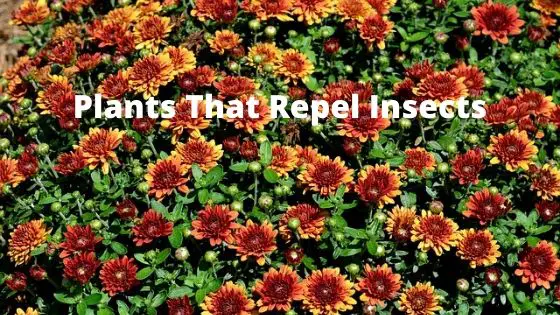Firstly, not all insects are bad for the garden, and we want to attract the good ones. But there are a lot of insects that cause damage, and even death to our plants. So here’s the growing-guides plants that repel insects(the bad ones).
Table of Contents
Plants That Repel Insects
There are many plants that have the reputation of deterring pests, and here’s a few to get us started. So to start let’s look at how plants repel insects, there are some plants that give off an odour to repel insects, and others that exude chemicals to repel insects.
Plants That Repel Insects-Flowers
There are quite a few flowers that are known to repel insects, below are the most popular and useful.
Petunias Repel Insects
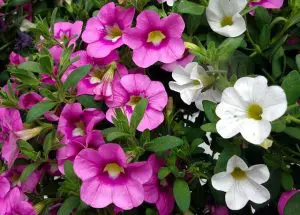
These pretty flowers come in many varieties and colours but they all have one thing in common. They repel insects! Including the asparagus beetle, aphids, Mexican bean beetles, tomato horn worms, and leaf hoppers.
Chrysanthemums Repel Insects
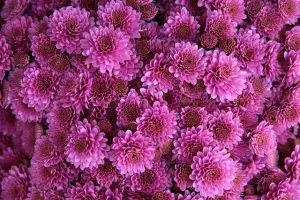
Pyrethrum, used by manufacturers of insect repellent sprays, is found naturally in chrysanthemums, and this makes them an excellent insect repelling flower. They are known to repel ants, ticks, Japanese beetles, roaches, silverfish, spider mites and bed bugs.
Marigolds Repel Insects
All types of marigolds are effective in repelling insects but some are better than others, so lets break this down further.
French Marigolds (Tagetes Patula)
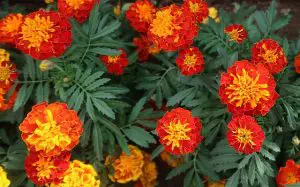
This is the variety that exudes a chemical from its roots that kills nematodes, and if nematodes are a problem, plant as many French marigolds as you can. The plant should be hoed into the soil at the end of the season to keep the nematodes away. They also repel whiteflies, making them a handy plant to grow with tomatoes, but they have a detrimental effect on bean plants so keep them apart.
Mexican Marigold (Tagetes Minuta)
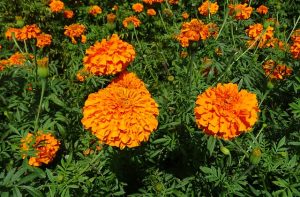
This is supposed to be the most powerful insect repellent flowering plant available, and can also inhibit weed growth. Even bindweed, and if you’ve ever had bindweed you’ll know how hard it is to eradicate. Mexican marigolds are also supposed to repel Mexican bean beetles, and even rabbits!
They should not be planted near beans or cabbages as they inhibit the growth of these plants.
Geraniums Repel Insects
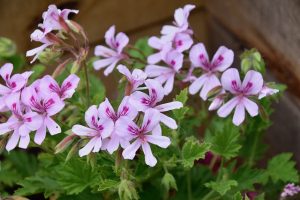
This annual flower comes in many different varieties and is known to repel cabbage moths, cabbage white butterflies, and Japanese beetles and will deter leafhoppers.
Nasturtiums Repel Insects
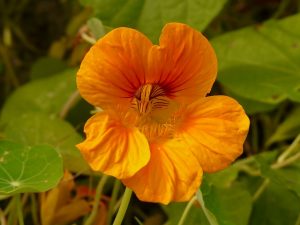
These members of the cress family are known to repel whiteflies, wooly aphids, cucumber beetles, squash borers, and many other pests. Unfortunately they also attract black flies (aphids) so keep them away from susceptible plants.
Asters Repel Insects
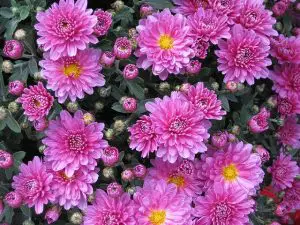
Asters are well known for repelling nematodes, leaf hoppers, asparagus beetles and other insects.
Spotted Dead Nettle (Lamium) Repels Insects

This annual plant is great for repelling many potato pest insects. Grow the flowering types for a nice display and attract beneficial insects whilst repelling potato pests.
Painted Daisy (Tanacetum) Repels Insects
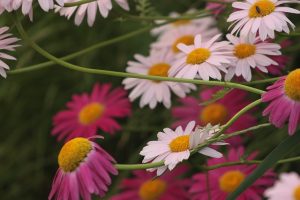
Like their relatives chrysanthemums, painted daisies (also known as pyrethrum) have natural insect repelling properties and repel nematodes, aphids, leafhoppers, ticks, harlequin bugs, spider mites, cabbage white butterflies, and cabbage moths.
Tansy Repels Insects
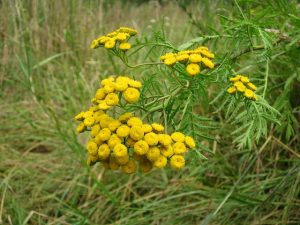
The oils in tansy are repellent to many insects including cut worms, squash bugs, cucumber beetles, cabbage white butterflies, cabbage moths, ants, flies, mosquitoes, Japanese beetles, and fruit moths like the codling moth.
Plants That Repel Insects-Herbs
There are many herbs that repel insects, and also make useful plants for your garden.
Anise Repels Insects
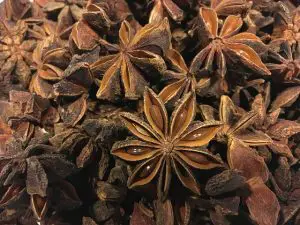
This plant, related to caraway and dill has a strong licorice flavour, and is a great plant for repelling aphids. This is due to the high number of predatory wasps that are attracted to anise, who also feed on aphids.
Basil Repels Insects
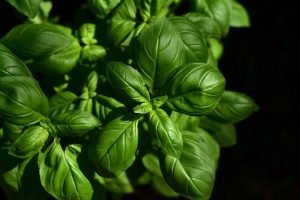
This aromatic herb has many uses in the kitchen and in the garden. Basil is good at repelling mosquitoes, thrips, flies and fruit flies.
Bay Leaf Repels Insects

Another kitchen favourite, bay leaves are known to repel weevils and moths. It can be mixed with other herbs like tansy and peppermint to make a potent insect repellent.
Borage Repels Insects
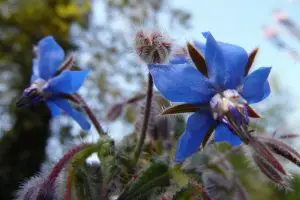
A great companion plant for tomatoes, squash, and strawberries in particular, borage repels tomato horn worms and cabbage white butterflies.
Catnip Repels Insects
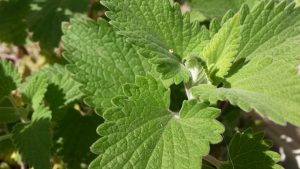
Also known as cat mint, catnip is a member of the mint family and contains insect repelling oils. Cat mint repels ants, fleas, Japanese beetles, aphids, weevils and squash beetles. Steep the leaves in water to make an insect repelling spray to protect your garden.
Chamomile Repels Insects
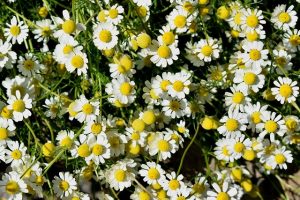
This plant grows like a weed in many places and is often over looked by gardeners because of this. It’s a really useful plant for many reasons, including its insect repelling qualities. Chamomile repels potato beetles and carrot flies, and it spreads itself readily around your garden.
Chervil Repels Insects

This plant is a relative to parsley and is a good companion plant for radishes, broccoli and lettuce. It also repels slugs and aphids.
Chives Repel Insects
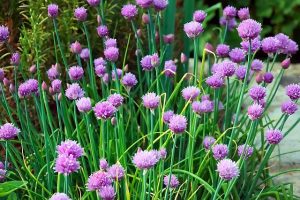
Members of the onion (allium) family, chives repel aphids from tomatoes. They also repel Japanese beetles and carrot rust fly. Plant chives with roses to eradicate black spot.
Coriander (Cilantro) Repels Insects
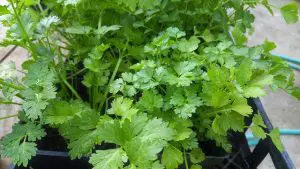
Due to it’s strong aroma, coriander is good for repelling aphids, potato beetles and spider mites. You can make a spray from coriander leaves that will prevent spider mites from infesting your plants.
Dill Repels (Some) Insects
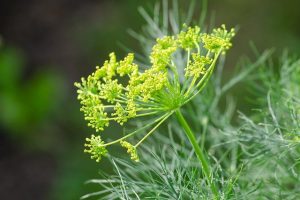
This is one of those herbs that attracts some pests whilst repelling others. Most of the insects dill attracts are beneficial including:-
- Hoverflies
- Swallowtail Butterflies
- Predatory Wasps
- Bees
However, dill also attracts the tomato horn worm, not a problem in the UK as yet but in other parts of the world this is a major problem. Dill repels aphids, squash bugs and spider mites.
Garlic Repels Insects
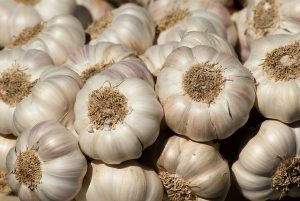
Plant garlic in companion with tomatoes to keep aphids away, it will also keep aphids from roses, apple and pear trees, cucumbers, lettuce and celery. Garlic accumulates sulphur which is a naturally occurring fungicide, that helps prevent disease. It also is effective in repelling spider mites too.
Hyssop Repels Insects
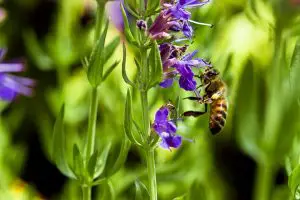
This herb has leaves that smell almost mint like, and repels cabbage moths and flea beetles.
Lavender Repels Insects
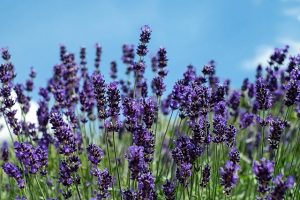
Attracting many pollinators that in turn repel many insects, lavender is a helpful plant to the organic grower. Lavender repels codling moths and whiteflies and will stand an attack from both rabbits and deer.
Lemon Balm Repels Insects
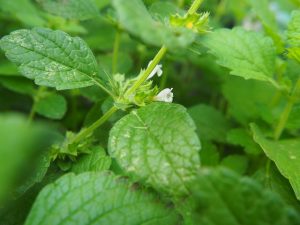
This strongly aromatic herb has the scent of lemon, very much like citronella. Lemon balm repels squash bugs and mosquitoes.
Oregano Repels Insects
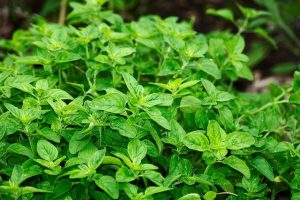
Along with its close relative marjoram, oregano repels cucumber beetles and cabbage white butterflies.
Peppermint Repels Insects

The strong smell of peppermint is due to it containing menthol, and it’s this menthol that repels a number of insects. Peppermint repels cabbage white butterflies, red ants, flea beetles, and aphids.
Rosemary Repels Insects
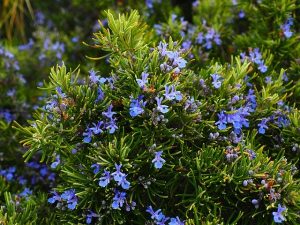
This aromatic herb is great at repelling cabbage moths and butterflies, bean beetles and carrot flies.
Rue Repels Insects
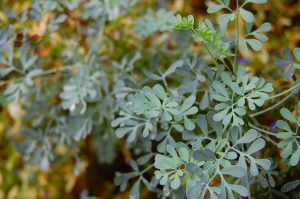
Also known as Ruta graveolens which is Latin for strong smelling rue, and I think describes rue perfectly. Rue repels Japanese beetles, aphids, onion flies, slugs, snails, silverfish (fish moths), and fleas.
Sage Repels Insects

Another great herb that repels problem pests, sage repels cabbage moths and butterflies, beetles, flea beetles, and carrot flies.
Spearmint Repels Insects
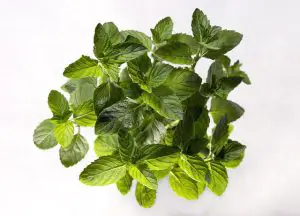
A truly beneficial plant for the organic gardener, mint, of which spearmint is just one, can become invasive. Even when grown in pots, the roots can, and do, spread out from the pot and colonise an area of ground. It’s hard to irradicate mint once it’s established so try to keep an eye on it.
Having said that, mint will repel cabbage white butterflies, ants,mice, rats, fleas, aphids, and flea beetles.
Tarragon Repels Insects
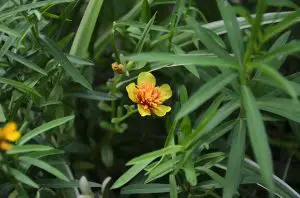
This tall growing herb that’s very useful in the kitchen, is also very useful in the garden, and in the war against pests.Tarragon repels almost all insects, so it’s a good plant to spread around the garden to keep pests away.
Thyme Repels Insects
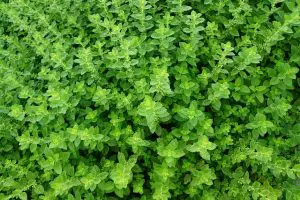
There are many varieties of thyme, variegated, tall, short, some with white flowers and some with purple flowers. The one thing they all have in common, well actually there are 2 things they have in common. They all attract pollinators and they all repel cabbage white butterflies and cabbage moths.
Wormwood Repels Insects
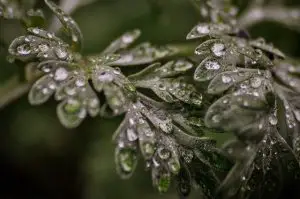
Related to tarragon, wormwood (Artemisia absinthium) has a strong odour that insects find repellent. Best used as a border plant, wormwood will repel many insects like moths, flea beetles, slugs, snails, fleas, and the cabbage white butterflies and cabbage moths. Wormwood contains the chemical absinthin that can be poisonous to other plants, so it’s best to grow wormwood on its own.
The #1 Best Insect Repelling Plant
OK, so this heading sounds a bit dramatic, and it is, but with good reason. There’s one flowering plant I never mentioned before because I believe it should stand alone.
Delphiniums / Larkspur
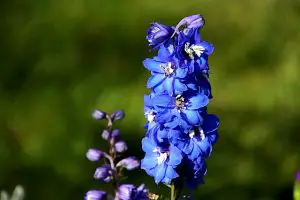
Larkspur and delphiniums do the same job here and are closely related, so let’s treat them as one. These striking flower spikes range in size from a foot to 7 feet tall, depending on variety. They don’t actually repel insects, they attract all manner of pests including the dreaded Japanese beetle.
The thing with delphiniums and larkspur is, they are poisonous, and every insect that tries to feed on this plant will die. So although they don’t repel insects, they do keep numbers down and keep pests away. Be warned though, both larkspur and delphiniums are also poisonous to humans and animals.
In fact mid Western farmers and cattlemen delay moving their herds until after these plants that are growing wild, die back. So keep them away from pets and children and livestock, horses etc… Both varieties are easy to grow from seed after frosts are gone.
They prefer full sun but will tolerate slight shade, and after a couple of years they will need to be thinned out. Otherwise they get too compacted and will suffer as a consequence. For more on delphiniums check out this post from the North Dakota State University.
Insect Repellent Plants For The Vegetable Garden
That concludes the growing-guides list of insect repellent plants, and all of the above can be used in the vegetable garden. If you are unsure of whether or not the plant is compatible with the vegetable you are growing, check out my companion planting guides here.
Don’t have any doubts, plants repel insects! There is scientific data that backs this up, here are some links to scientific papers on plants that repel insects.
It’s not possible to grow all of the plants listed above, try a few and see how they work for you. Remember it’s not an exact science, and what works in one area might not in another. It’s all about trial and error, but that’s gardening. 🙂
Have you had any successes or failures with plants that repel insects? Leave me a comment and let me know.

